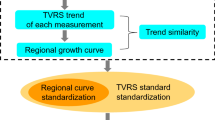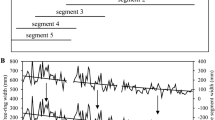Summary
Tree-ring standardization methods were compared. Traditional methods along with the recently introduced approaches of regional curve standardization (RCS) and power-transformation (PT) were included. The difficulty in removing non-climatic variation (noise) while simultaneously preserving the low-frequency variability in the tree-ring series was emphasized. The potential risk of obtaining inflated index values was analysed by comparing methods to extract tree-ring indices from the standardization curve. The material for the tree-ring series, previously used in several palaeoclimate predictions, came from living and dead wood of high-latitude Scots pine in northernmost Europe. This material provided a useful example of a long composite tree-ring chronology with the typical strengths and weaknesses of such data, particularly in the context of standardization. PT stabilized the heteroscedastic variation in the original tree-ring series more efficiently than any other standardization practice expected to preserve the low-frequency variability. RCS showed great potential in preserving variability in tree-ring series at centennial time scales; however, this method requires a homogeneous sample for reliable signal estimation. It is not recommended to derive indices by subtraction without first stabilizing the variance in the case of series of forest-limit tree-ring data. Index calculation by division did not seem to produce inflated chronology values for the past one and a half centuries of the chronology (where mean sample cambial age is high). On the other hand, potential bias of high RCS chronology values was observed during the period of anomalously low mean sample cambial age. An alternative technique for chronology construction was proposed based on series age decomposition, where indices in the young vigorously behaving part of each series are extracted from the curve by division and in the mature part by subtraction. Because of their specific nature, the dendrochronological data here should not be generalized to all tree-ring records. The examples presented should be used as guidelines for detecting potential sources of bias and as illustrations of the usefulness of tree-ring records as palaeoclimate indicators.
Similar content being viewed by others
Author information
Authors and Affiliations
Rights and permissions
About this article
Cite this article
Helama, S., Lindholm, M., Timonen, M. et al. Detection of climate signal in dendrochronological data analysis: a comparison of tree-ring standardization methods. Theor Appl Climatol 79, 239–254 (2004). https://doi.org/10.1007/s00704-004-0077-0
Received:
Revised:
Accepted:
Published:
Issue Date:
DOI: https://doi.org/10.1007/s00704-004-0077-0




